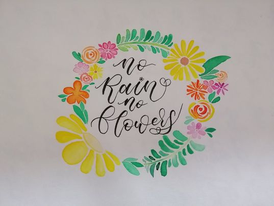Reported by:
Ong Chen Xi Jr2Z(2)
From the 7th to the 15th of July, The Western Calligraphy Club organized a calligraphy competition held over Google Form. Its goal was to get people interested in the art, and was open to both club members and non-members alike. Among other instructions, participants could only use watercolour or brush pens to make pieces in the brush lettering style.
The competition instructions
As seen above, the Junior category could choose from the sentences “Thank you to the healthcare workers at the frontline” and “Don’t let pain define you, let it refine you”. Meanwhile the Senior category could choose from the sentences “We are not living in fear, we are living in faith” and “We are stronger in the places we have been broken”.
 The Junior category winner’s piece
The Junior category winner’s piece
The competition was divided into the Junior and Senior categories, and its results came out on the 26th. The results are as listed below: (Pink is for the Junior category, blue is for the Senior category, winning pieces can be found at this link)
JUNIOR
|
SENIOR
|
PLACE
|
NAME
|
CLASS
|
PLACE
|
NAME
|
CLASS
|
Gold
|
Chong Kar Ann
|
Jr3Z(1)
|
Gold
|
Chelsea Chua Si Yu
|
Sr2ScD
|
Silver
|
Lee En Qi
|
Jr1Z(6)
|
Silver
|
Chang Jie Ee
|
Sr2ScA
|
Bronze
|
Ng Sze Yao
|
Jr2Z(2)
|
Bronze
|
Lim Kai Qi
|
Sr1ScA
|
Honorary Award
|
Ho Jia Yu
|
Jr1Z(4)
|
Honorary Award
|
Ng Wei
|
Sr3ComA
|
Honorary Award
|
Cheong Hoi Kei
|
Jr1S(4)
|
Honorary Award
|
Kew Ee-Lynn
|
Sr1ScE
|
Honorary Award
|
Chye Shu Yee
|
Jr2Z(4)
|
Honorary Award
|
Tan Wei Shuen
|
Sr3ComA
|
Honorary Award
|
Chloe Ling Yen Ee
|
Jr3S(3)
|
|
–
|
–
|
Honorary Award
|
Pang Xuan Lyn
|
Jr1Z(1)
|
|
–
|
–
|
To learn more about the inner workings of calligraphy, we interviewed the first-place winner of the Senior category, Chelsea Chua Si Yu from Sr2ScD.
 Chelsea Chua
Chelsea Chua
Q: What made you join the competition?
A: Well, I am a member of the Western Calligraphy Club, so I got to know about this competition pretty early on. I joined mainly because I thought it was a fun little opportunity to put my skills to the test.
I also value other people’s opinions and use them to improve. While calligraphy does have its general rules (like how upstrokes are written with less pressure and downstrokes are written with more), it’s also a form of art, and art is subjective. For my own piece, I would love to hear people’s opinions on what I could’ve done to improve it, like suggestions on how to fill in the weird little space between the words “we have” at the bottom, or how they would’ve decorated the empty spaces in the piece.
Q: What got you interested in calligraphy?
A: I had a friend in my class during Jr2 who was extremely talented at art. She always brought her art supplies like alcohol markers and sometimes her palette to school, but most importantly: her black brush pen. She let me try it out and my first attempt at calligraphy was horrendous to say the least, but she lent me her pen anyway and taught me how to write better.
One thing that kept my passion for calligraphy from dwindling however, was actually my interest in K-Pop. I would come across pictures of journals made by K-Pop fans on Instagram, and they inspired me to keep trying different things with calligraphy (like mixing colours, adding drop shadows and all that stuff).
 Chelsea Chua’s piece
Chelsea Chua’s piece
Q: What aspect of calligraphy is your favourite?
A: Probably the fact that: one, you can mix colours to create a gradient effect; and two, you can add little decorations on top of the words like sparkles and highlights. I used to take “书法” (Chinese calligraphy) classes when I was in primary school, but I jumped ship when I realised that Western calligraphy gave us more creative freedom.
The most fun part about calligraphy, on the other hand, would probably be the experimenting part. I like testing different colour combinations, especially wacky ones that don’t seem like they work!
Q: Do you have a style of calligraphy?
A: I don’t really think it stands out, but it tends to be more curvy and also really uneven. I’ve been writing calligraphy, brush pen calligraphy to be specific, for about three to four years, and I joined the Western Calligraphy Club last year. Normally we’re taught to write calligraphy so that the words are parallel to each other at first because it’s easier, but once you get the gist of it you can just experiment on your own. I like a bit of messiness as it makes it look more fun in a way.
Q: What are your thoughts on winning the competition?
A: When I first realized I won, I actually laughed because I was in the middle of my co-curricular activity. I found it kind of unbelievable. It’s been a day after that, and I still find it unbelievable but I’m calmer about it now. I am proud of myself though I do think I could’ve done better. I’m pretty happy with my piece, but I do think I could have added more details like drop-shadows or decorations.
Q: Do you have anything you would like to say to people who are interested in calligraphy?
Speaking from personal experience, my first attempt at calligraphy was a monstrosity (like I said earlier). But we all start from somewhere, so just keep practising. If it gets to a point where it frustrates you, then just take a break, because calligraphy is supposed to be something that you can enjoy. But if you really want to learn more about calligraphy, you’re always welcome to join the Western Calligraphy Club!
All in all, this was an interesting interview with the first-place winner of the English Calligraphy Competition. For anyone interested in calligraphy, we hope you can use this as reference for your future projects.
 Chelsea Chua’s favourite piece
Chelsea Chua’s favourite piece


 The Junior category winner’s piece
The Junior category winner’s piece


